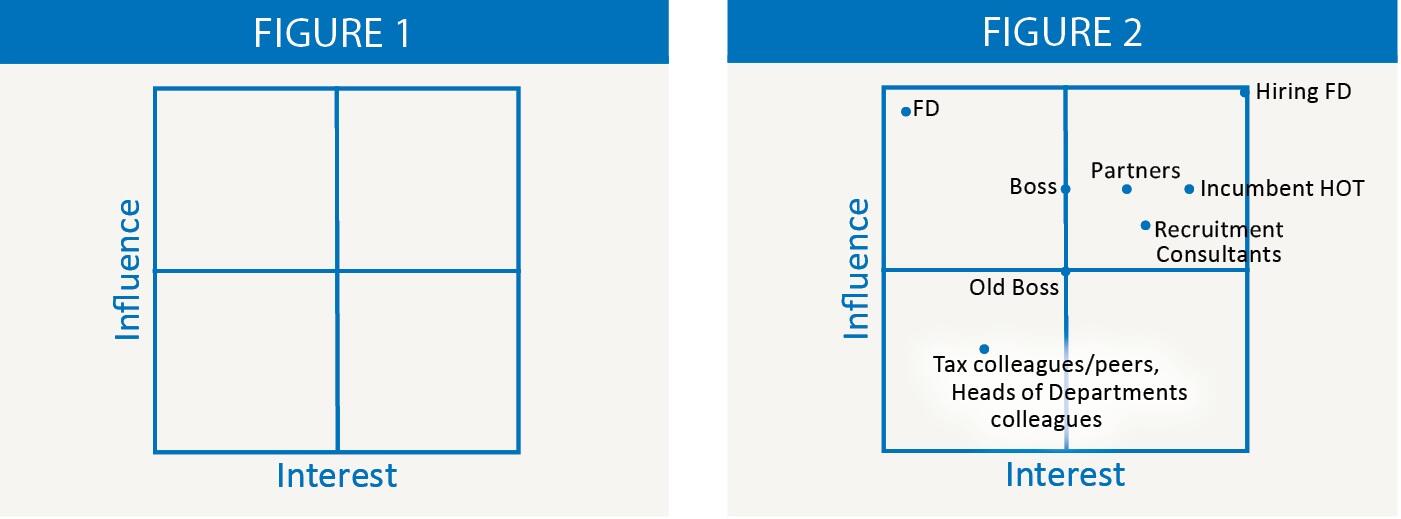Leveraging your stakeholders

Jo Maughan shows you how to work out who the important people in your career are, and how to tap into their influence
Key Points
What is the issue?
You can help yourself move up the career ladder by working out who your career stakeholders are, getting them interested in you, and tapping into their influence.
What does it mean to me?
Learn and use a simple exercise to identify your career stakeholders today.
The article is relevant to tax professionals just starting out in their career, those who are at a career plateau, and those who want to give themselves the best chance of getting their next promotion.
What can I take away?
A tool to use again and again. New insights into where you should spend your time to get ahead in your career. Inspiring stories.
Don’t let your peers overtake you on the career ladder. It’s never too early (or too late!) to identify and manage your career stakeholders. That’s what many of your peers are doing as I found out to my cost 20 years into my tax career.
It’s 2011. My manager turns to me as we step into the shiny, glass atrium in Head Office. We’re about to walk back to our respective desks. His pale face is smiling and is unusually animated as he says in his soft voice, ‘Anne is doing such a good job leading the risk project. She took me through it yesterday and I’m amazed at how much she’s achieved in just three months. And Tim, he’s been managing the team through a huge peak of work. They’re going to meet the annual filing deadline two weeks early! That’s unheard of. We usually file at 11.59pm on the deadline day.’
I feel a sharp jolt of surprise, and think: ‘How does he know? They don’t even report to him!’
In that moment, I realised how my two colleagues had been actively promoting themselves to MY boss! I also understood how it was that their careers seemed to be progressing faster than mine: they had identified and were actively managing their career stakeholders. He was one of them!
Although very successful in my first (tax) career, I never dedicated time to planning or managing my relationships with people who had an interest in my success or who could help me achieve my career goals: I’d felt uncomfortable promoting myself so I’d networked and used LinkedIn on a ‘needs must’ basis, with no under-pinning strategy; I’d believed that to be more strategic would be Machiavellian or ‘using people’. This led me to be at a career plateau in 2011. It took that jolt of surprise, and a leadership development programme to wake me up.
If you relate to what I’m writing here, join the club. It’s fairly common for tax professionals to have my old outlook – we have excellent attention to detail, we problem solve, we deliver well under pressure but many of us do not count strategic thinking and influencing skills among our top strengths. It doesn’t occur to us to explicitly and strategically manage our relationships with those who can help us reach our career goals. Also, if you’re not the most confident person, it’s easy to fall prey to the soundtrack of your ‘critical inner voice’, which is telling you you’re not important enough for people to want to help you. Ignore that voice!
So don’t be like I was. Inform yourself about what you could be doing, and what many of your peers are intuitively doing to progress their careers. You can then take action to get more strategic and focused.
Intrigued? Okay, here’s what I suggest: review your career stakeholders using my simple stakeholder management tool.
Here’s what Linda (not her real name), a Big 4 firm Senior Manager, said after using the tool. ‘I’ve decided to stop being so naive and to start thinking about these things! And to have a bit of confidence in networking and getting to know people.’
Let me take you through how to use the tool using tax manager Andrew (not his real name) as an example.
Step 1
Decide on your desired career objective. This can be a near-term one, such as: be successful in your current role, get your next promotion; or a longer-term one, such as: make Tax Partner, be a Head of Tax, work three days a week as a Tax Director in a Big 4 firm. Andrew’s objective was to become a FTSE250 Head of Tax.
Step 2
Hold your desired objective in your mind.
Step 3
Draw a four quadrant grid on a sheet of paper. Label the x axis, interest. Label the y axis, influence. See figure 1.
Step 4
On a separate sheet of paper, list all the people you currently know who (a) have an interest in you succeeding or failing; and/ or (b) could impact or be impacted by you. Andrew listed: his boss, recruitment consultants, tax colleagues and peers, heads of departments in his current company (Head of Legal, the Company Secretary, Head of Internal Audit etc), colleagues in other departments, the Finance Director in his present company, his old boss.
Step 5
Think of all the people/groups of people you are yet to know who have an interest or could help you. Andrew listed: the hiring Finance Director in the future FTSE250 company, the incumbent Head of Tax in the future FTSE250 company, tax partners, audit partners.
Step 6
Plot the people/ groups on the grid. Don’t over think this part of the exercise – the purpose of the tool is to highlight where you have gaps. It’s not an exact science.
Andrew’s grid is shown in figure 2. He plotted his boss at (5,7) because Andrew judged his boss was ambivalent as to whether he became a FTSE250 Head of Tax (5), but he did have influence to help Andrew if Andrew chose to involve him and seek his help (7). He plotted recruitment consultants as a group at (7, 6). He plotted his tax colleagues and peers, heads of departments, and colleagues in other departments at (3,3) as he assessed they had low interest and influence on him getting a Head of Tax role. He plotted his Finance Director at (1,9) because Andrew assessed his FD wasn’t interested in whether Andrew stayed or left but had he been, or if Andrew was able to persuade him to be, he had high influence. He plotted his old boss at (5,5) because she was vaguely interested in his career (5), but not well networked (5). He plotted the hiring Finance Director (10,10), the incumbent Head of Tax (8,7). He placed the tax and audit partners at the firms at (7,7) because they’d be interested to build long-term client relationships with Andrew and they had considerable influence with client companies.

Step 7
Label the four quadrants of the grid as follows: least important (bottom left); show consideration (bottom right); meet needs (top left); key players (top right).
Step 8
Now for the exciting bit: review your results. You want to have strong, personal relationships with named individuals in the key players’ quadrant, and you want them to know your career goals.
Andrew was surprised by his results especially as he’d been reluctant to use ‘another four box grid’. Although he had people and groups in the key players’ quadrant, he’d not told the individuals he already knew there about his career objectives. With the recruiters, he’d treated them as a nuisance rather than recognising that he would benefit from cultivating relationships with the 1-2 he most liked. With the tax partners, he knew a couple but he did not have a strong relationship with any individual partner, and had represented them as a group! It was the same with the audit partners. As for a future hiring Finance Director and a future incumbent Head of Tax, Andrew vaguely knew a couple outside his company.
Here are some questions to help you review your results: How many people do you have in the key players’ quadrant? Who do you need to build/ strengthen relationships with? Where do you need to spend more/ less time? How can you get those with high influence interested in you?
Step 9
Conclude your review, decide your actions and make them SMART.
Andrew concluded he was spending too much time in the ‘least important’ quadrant because he felt comfortable with those people, whereas he needed to spend more time with the ‘key players’. He realised he needed to build his confidence to be able to do this.
His actions were:
- Go for coffee with two recruitment consultants, two tax partners and one audit partner (all of whom he already knew) within three months. He would get to know them some more, share his career goals with them and ask for their help.
- Find and join two or three LinkedIn groups where Finance Directors and Heads of Tax hang out, within one week.
- Continue confidence coaching with me.
Remember Linda? Here’s one thing she decided to do after doing her stakeholder grid: ‘We had a great internal talk with a very senior female tax partner the other day. I really valued what she said so I am going to drop her an email to let her know. I wouldn’t have done that before!’
Key takeaway
If there’s one thing I want you to take away from this article, it’s this: invest time in planning your career. Don’t just sit there waiting for it to happen.


